Finding large black ants in your home during winter? Hearing strange rustling sounds in your walls? These could be signs of carpenter ants - wood-destroying insects that can cause serious structural damage if left unchecked. Unlike termites that eat wood, carpenter ants excavate galleries to build their nests, weakening wooden structures over time.
After four years as a registered technician and working with our family business that’s served the DMV area for over 50 years, I’ve seen countless carpenter ant infestations. The good news is that these pests leave clear warning signs long before major damage occurs. Learning to recognize these signs of carpenter ants early can save you thousands in repair costs.

Most Common Signs of Carpenter Ants
Carpenter ants are sneaky. They prefer to stay hidden in wood cavities and only venture out to forage for food, typically after dark. However, they leave behind telltale evidence of their presence that trained eyes can spot.
Sawdust-Like Frass Piles
One of the most obvious signs of carpenter ants is finding small piles of wood shavings called frass. Unlike termite pellets, carpenter ant frass looks like pencil shavings mixed with insect body parts and dead ants. This debris gets pushed out through small “kick-out” slits in the wood.
What does the science say?
According to NC State Extension research, carpenter ants create specialized “kick-out” openings in wood structures to expel frass and debris. These slits are strategically positioned to efficiently remove excavated material without compromising the structural integrity of their gallery systems. The research shows that frass composition varies significantly based on wood moisture content, with higher moisture levels producing darker, more compacted debris.
The frass color tells a story too. Lighter-colored shavings indicate fresh, healthy wood excavation. Darker frass suggests the ants are working in moisture-damaged or fungus-infested wood - a red flag for potential structural issues.
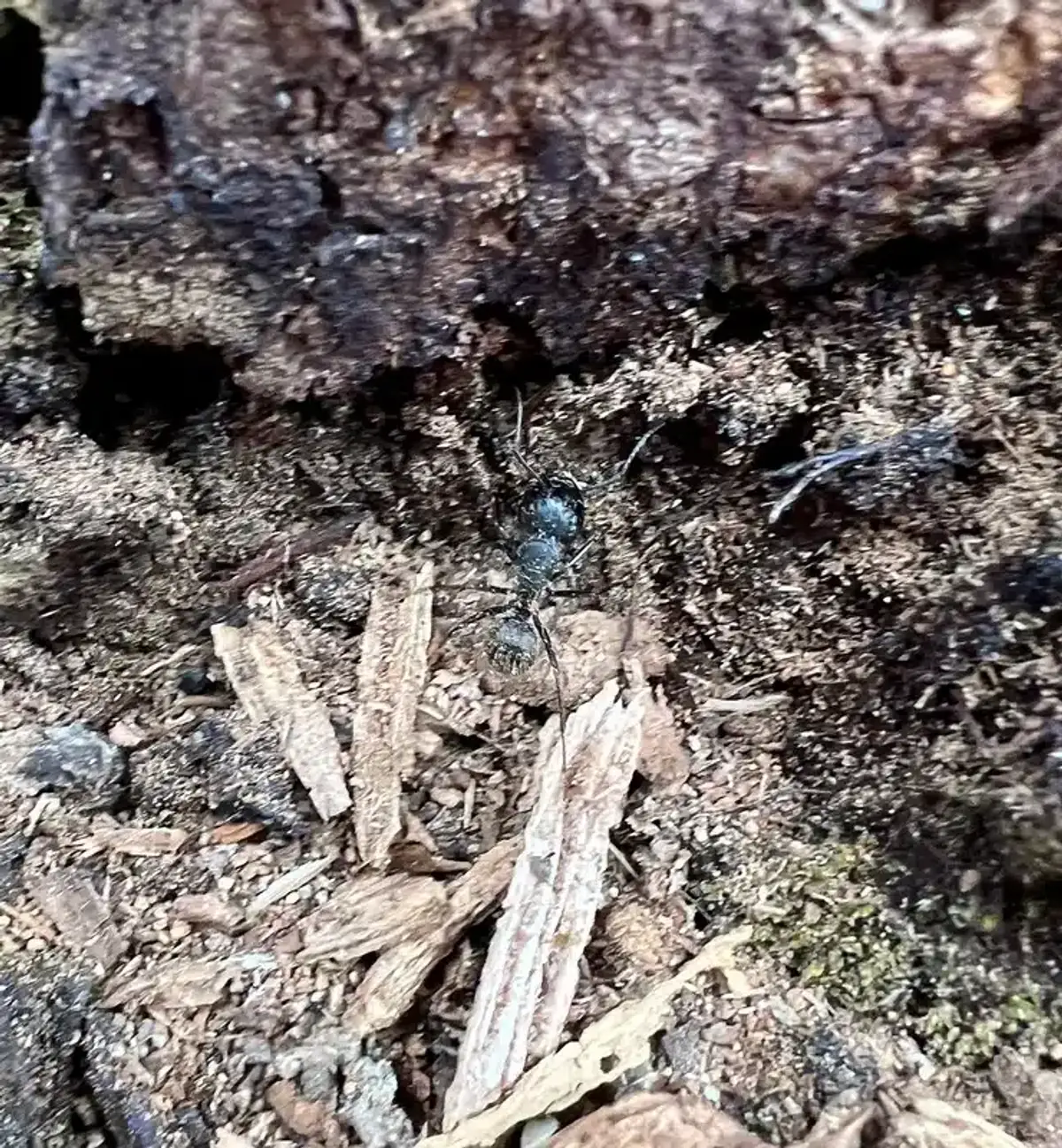
Smooth, Clean Galleries in Wood
If you find damaged wood, examine the tunnels closely. Carpenter ant galleries have smooth, sandpapered walls that follow the wood grain. The tunnels connect through harder summer-wood sections, creating an intricate network.
This differs dramatically from termite damage. Termites vs ants damage shows a key distinction - termite galleries contain mud and soil, while carpenter ant excavations remain clean and dry.
Rustling Sounds in Walls
Mature carpenter ant colonies produce audible sounds, especially when disturbed. You might hear a dry, cellophane-like crackling as workers gnaw wood or tap their mandibles against gallery walls. These sounds are most noticeable during peak activity periods in late spring and early summer.
If you’re hearing mysterious sounds in your walls, check out our guide on ants in walls for more detailed information about wall-dwelling ant behavior.
Visual Signs of Carpenter Ants
Large Black Ants Indoors
Spotting large black ants inside your home, especially during late winter, strongly suggests an indoor nest. Consistent indoor activity indicates a more serious problem than occasional spring sightings which might trace back to outdoor parent nests.
What does the science say?
Research from University of Maryland Extension demonstrates that carpenter ant colony behavior follows predictable seasonal patterns. Indoor sightings during winter months indicate established satellite colonies, as outdoor parent colonies remain dormant in cold temperatures. The study shows that indoor winter activity is a reliable indicator of structural nesting, requiring immediate professional assessment.
Carpenter ants are notably larger than common household ants. Workers range from ¼ to ½ inch long, with queens reaching up to ¾ inch. Their size alone makes them stand out from other ant species you might encounter.
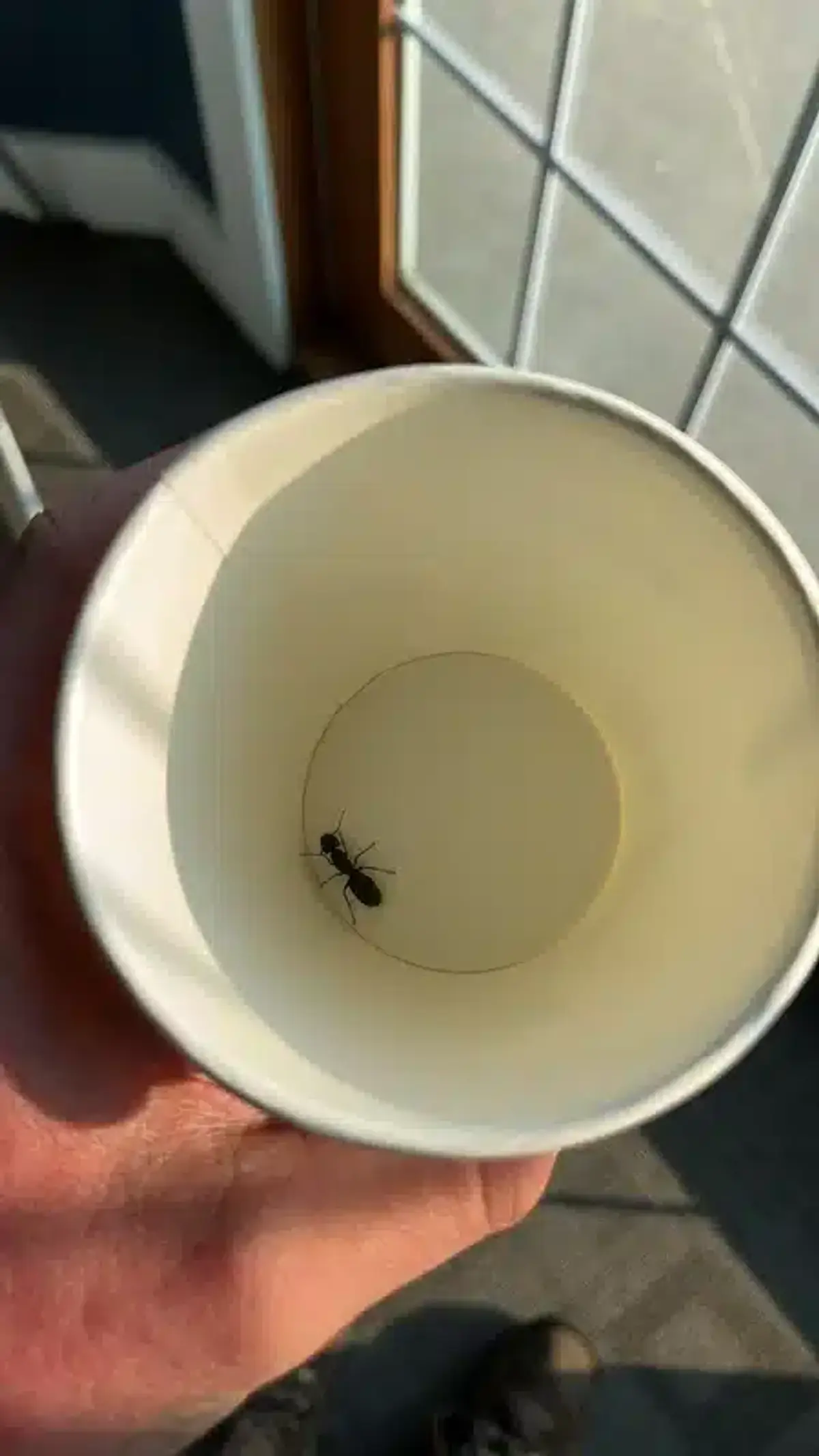
Winged Swarmers in Spring
Winged carpenter ants (swarmers) emerge during spring mating flights, typically from March through July. These reproductive ants indicate a mature colony that’s been established for at least three to six years.
Finding swarmers indoors confirms a nest somewhere in your structure. Outdoor swarmers might simply indicate nearby colonies, but they still warrant investigation. For more details about identifying these reproductive ants, read our carpenter ant queen guide.
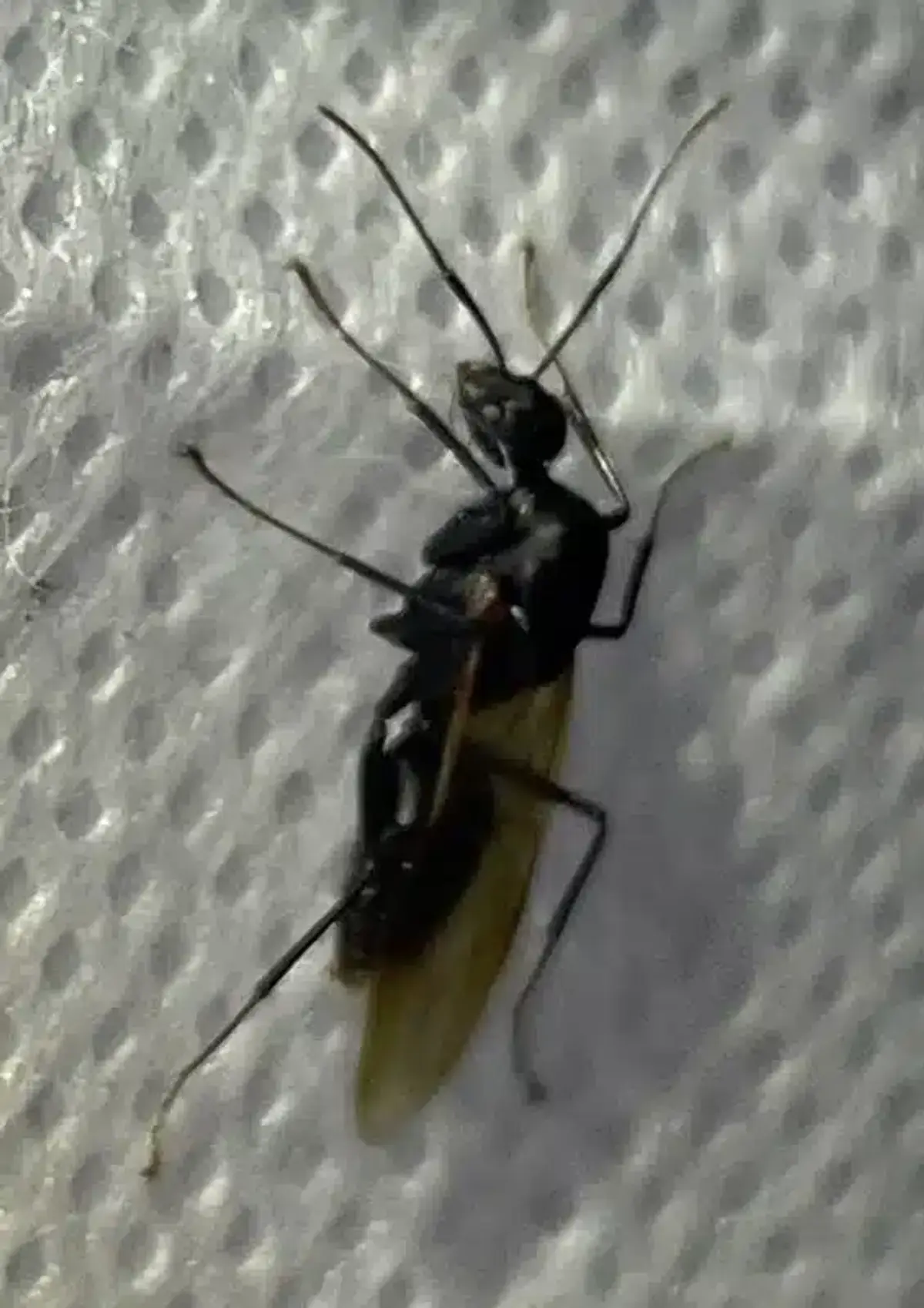
Dead Ant Accumulations
Piles of dead ants near windows, doors, or baseboards indicate nearby nest activity. Carpenter ants maintain clean colonies by removing deceased workers, creating these telltale accumulations. The behavior is explained in detail in our article about why ants carry dead ants.
Environmental Signs of Carpenter Ants
Moisture Damage Correlation
Carpenter ant parent nests require consistently damp wood with moisture content above 15%. Common locations include areas around leaky windows, roof damage, plumbing leaks, and poorly ventilated crawl spaces.
The ants don’t cause the moisture problems, but they take advantage of them. Addressing water issues is often more critical for your home’s structural integrity than the ants themselves.
Essential Moisture Prevention Steps
- Fix Leaks Immediately: Address plumbing, roof, and window leaks before they create ideal nesting conditions
- Improve Ventilation: Ensure proper airflow in crawl spaces, attics, and basements to reduce humidity
- Clear Drainage: Keep gutters clean and ensure water flows away from your foundation
- Monitor Wood Moisture: Use a moisture meter to check wooden structures - anything above 15% attracts carpenter ants
Outdoor Foraging Trails
Look for well-beaten paths leading from outdoor nests to your home. These trails can extend 100 to 300 feet, following tree branches, utility wires, or foundation cracks. Ohio State University Extension research shows these highways connect parent nests with satellite colonies inside structures.
During evening hours, you might observe streams of worker ants using these routes to transport food back to the colony.
Seasonal Activity Patterns
Understanding when carpenter ants are most active helps with detection and treatment timing. Their behavior changes dramatically throughout the year, affecting which signs you’re likely to notice.
Spring Activity Surge
March and April mark the beginning of carpenter ant season. Colonies reactivate after winter dormancy, and you’ll start seeing foraging workers and the first swarmers. This is when frass production increases as workers expand existing galleries.
Summer Peak Activity
June and July represent peak carpenter ant activity. Colony populations reach their highest numbers, making this the best time to detect audible signs and observe foraging trails. Worker ants are most visible during these months.
Fall Preparation Period
August and September bring a second wave of egg-laying and increased protein foraging. You might notice more aggressive food-seeking behavior as colonies prepare for winter.
Winter Dormancy
Outdoor colonies become dormant during winter months, but indoor nests in heated spaces may remain active year-round. Winter ant behavior varies significantly depending on nest location and temperature conditions.
Satellite Colonies vs Parent Nests
Carpenter ant infestations involve complex colony structures that affect treatment approaches. Understanding the difference between parent and satellite nests helps explain why you might see signs of carpenter ants in multiple locations.
Parent Nest Characteristics
The parent nest always contains the queen, eggs, and young larvae. It’s located in consistently moist wood, often outdoors in tree stumps, logs, or moisture-damaged structural wood. These nests produce the frass and audible activity signs.
Satellite Colony Indicators
Satellite nests house older larvae, pupae, and workers in drier locations like wall voids, insulation, or hollow doors. A single parent colony can maintain up to 20 satellite sites, explaining why ant activity might appear throughout your home.
Workers move freely between sites, so eliminating only satellite colonies rarely solves the problem completely.
Using Signs to Locate Colonies
Detecting signs of carpenter ants is just the first step. Using these clues systematically helps pinpoint nest locations for effective treatment.
Night Survey Techniques
Carpenter ants are primarily nocturnal, beginning major foraging about 15 minutes after sundown. Use a red-beam flashlight to follow ant trails without disturbing their behavior. Focus on areas near plumbing, sinks, and attic junctions where moisture collects.
Exterior Perimeter Inspection
Walk your property’s perimeter, examining moisture-compromised wood, tree contacts, and utility penetrations. Look for the characteristic smooth galleries and frass accumulations that indicate active nests.
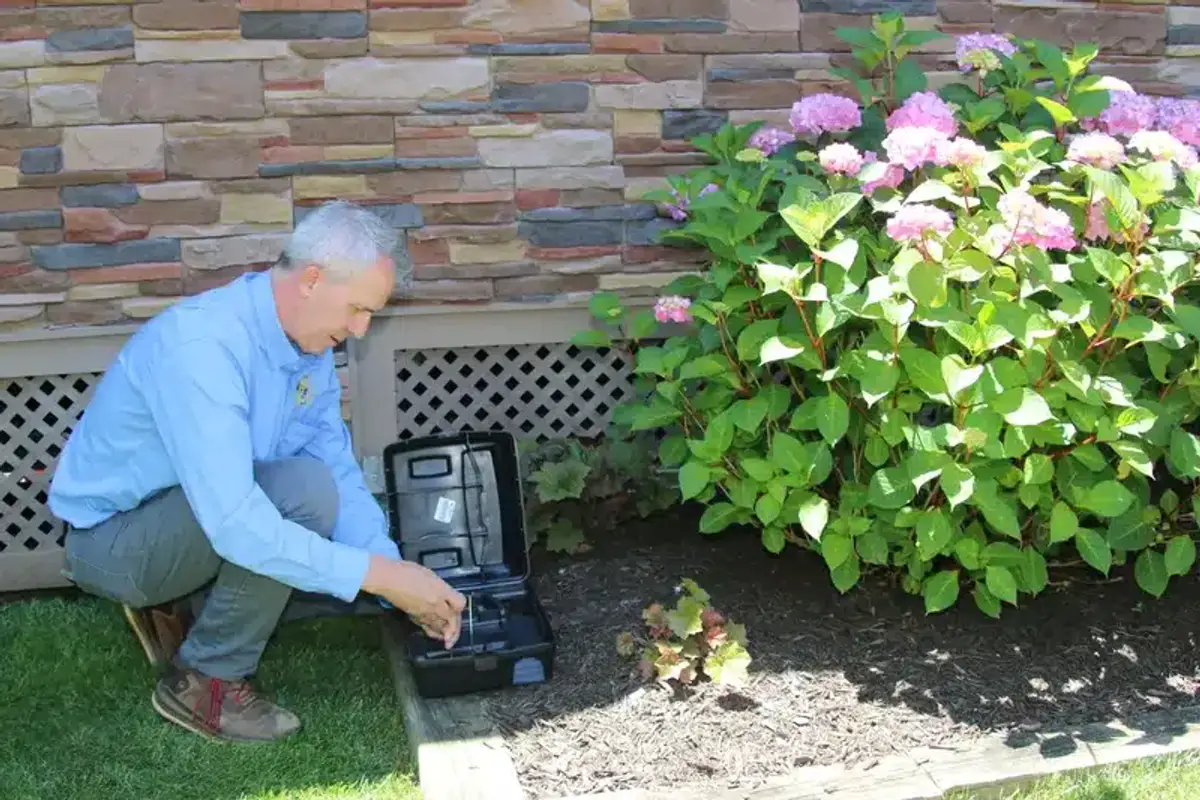
Probing and Listening Methods
Gently probe suspect timber with a screwdriver to test for hollow sections. Use a mechanic’s stethoscope to listen for rustling sounds in wall cavities. These hands-on techniques reveal hidden damage not visible from surface inspection.
Documentation for Treatment
Proper documentation of signs of carpenter ants guides treatment decisions and provides baseline measurements for success evaluation.
Record Keeping Essentials
Maintain a log noting date, temperature, weather conditions, ant numbers, and specific locations of activity. Include moisture readings from suspected nest areas using a wood moisture meter.
Photographic Evidence
Capture high-resolution photos of frass piles, kick-out holes, gallery cross-sections, and any swarmers you find. These images help professionals understand the infestation scope and plan targeted treatments.
Specimen Collection
Preserve worker and swarmer specimens in alcohol-filled vials for laboratory confirmation. This ensures accurate species identification, which affects treatment approaches. Our carpenter ant vs black ant guide helps distinguish between species.
Carpenter Ant Damage Indicators
Some signs of carpenter ants indicate potential structural compromise requiring immediate attention beyond pest control.
Kick-Out Slits and Holes
Small rectangular slits in wood surfaces mark where ants push out frass. Multiple kick-out holes in load-bearing timbers suggest extensive internal damage requiring professional evaluation.
Hollow-Sounding Wood
Wood that sounds hollow when tapped or feels soft when pressed may have extensive internal galleries. This is particularly concerning in sill plates, support beams, and porch posts where structural integrity matters most.
Localized Sagging
Visible sagging in floors, ceilings, or rooflines near areas with carpenter ant activity suggests compromised structural members. This requires immediate professional assessment.
When to Call Professional Pest Control
While homeowners can identify many signs of carpenter ants, certain indicators warrant professional intervention.
Multiple Location Activity
Finding ant activity in more than one room or level suggests a well-established colony network. Professional treatment addresses both parent and satellite nests simultaneously.
Structural Element Involvement
Any evidence of carpenter ant activity in load-bearing wood requires professional evaluation. The combination of moisture damage and ant excavation can compromise structural integrity.
Recurring Infestations
If carpenter ant activity returns within 12 months despite DIY treatments, professional intervention is needed. This pattern indicates missed nests or inadequate treatment coverage.
Indoor Swarmers
Winged ants emerging inside your home on consecutive days confirms an indoor nest requiring professional location and treatment.
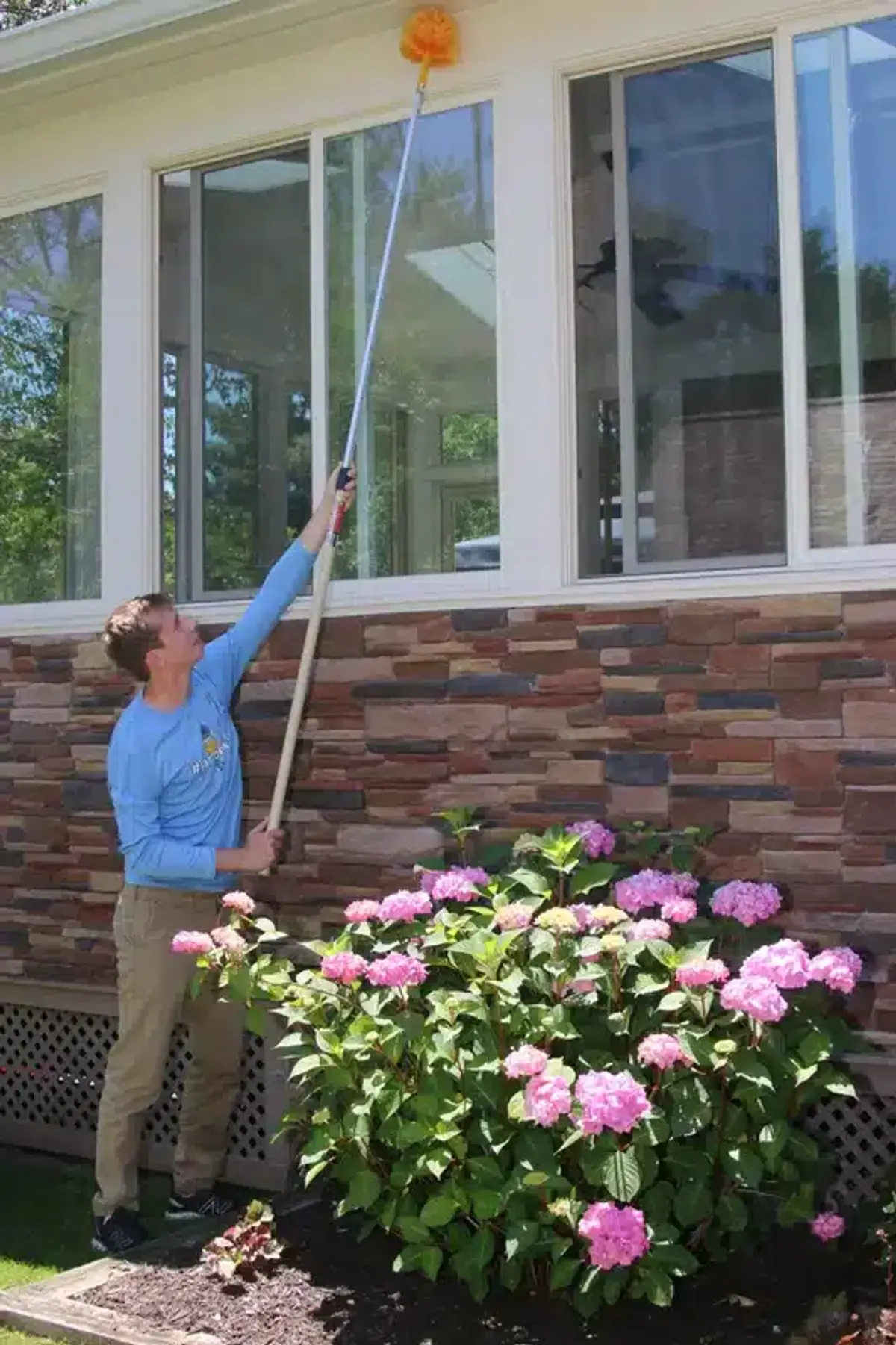
Recognizing the signs of carpenter ants early protects your home from costly structural damage. These wood-destroying pests work slowly compared to termites, giving you time for thoughtful remediation when you catch the warning signs.
Remember that carpenter ants often indicate underlying moisture problems that pose greater risks than the ants themselves. Addressing water issues alongside ant control provides comprehensive protection for your home’s structural integrity.
If you’ve identified multiple signs of carpenter ant activity, especially in structural elements or multiple locations, don’t wait for the problem to worsen. Our registered technicians have the experience and tools to locate hidden nests and implement effective treatment strategies.
Have questions about potential carpenter ant activity in your home? Call us at 703-683-2000 for a professional consultation, or email us at info@bettertermite.com. We’ll help you identify the signs and develop a treatment plan to protect your property.
Frequently Asked Questions
How can I tell if I have carpenter ants or termites?
+
Carpenter ants leave clean, smooth galleries with sawdust-like frass piles, while termites create mud-filled tunnels with pellet-shaped droppings. Carpenter ants are larger and visible, whereas termites avoid light and stay hidden in their mud tubes.
What time of year are carpenter ants most active?
+
Carpenter ants are most active from March through July, with peak activity in June and July. They become dormant in winter unless nesting in heated indoor spaces, where they may remain active year-round.
Do carpenter ants actually eat wood?
+
No, carpenter ants don't eat wood like termites do. They excavate galleries in wood to create nesting spaces, pushing out the wood shavings as frass. They feed on insects, honeydew from aphids, and household food sources.
Why do I only see carpenter ants at night?
+
Carpenter ants are primarily nocturnal insects that begin foraging about 15 minutes after sundown. This behavior helps them avoid predators and reduces the risk of detection while they travel between nests and food sources.
How long does it take carpenter ants to damage a home?
+
Carpenter ant colonies grow slowly, taking 3-6 years to mature. Significant structural damage typically occurs over several years of activity, giving homeowners time to detect and address infestations before major problems develop.
Can I treat carpenter ants myself?
+
DIY treatments often fail because carpenter ants maintain multiple nest sites that are difficult to locate and eliminate completely. Professional treatment addresses both parent and satellite colonies simultaneously for lasting results.
What attracts carpenter ants to my home?
+
Carpenter ants are attracted to moisture-damaged wood, food sources, and shelter. They establish parent nests in consistently damp wood and create satellite colonies in drier areas like wall voids and insulation.
How far do carpenter ants travel from their nest?
+
Carpenter ants can travel 100-300 feet from their nest while foraging for food. They create well-defined trails using tree branches, utility wires, and foundation cracks as highways between nests and food sources.
With five years of hands-on experience in the pest control industry, George Schulz is a registered technician with the Virginia Pest Management Association and a proud third-generation professional in a family business that’s been protecting homes for over 57 years. He manages and trains a team of service pros while also leading internal research efforts—recently spearheading a deep-dive review of thousands of documents on pest control materials to hand-pick the most kid and pet friendly, most effective solutions tailored specifically for homes in the DC metro area.
